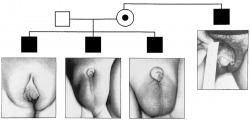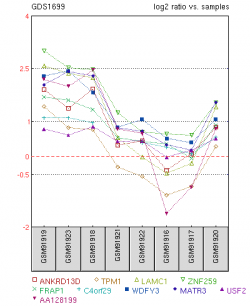This web page was produced as an assignment for Genetics 677, an undergraduate course at UW-Madison.
Conclusions and future direcation continued
So with such a selective pressure, the sequence is conserved. Between individuals the gene may be highly conserved. With it's interactions with wnt signaling pathways and other known cancer related systems, AR is a great target for treating cancer. In fact, some drugs have already been developed to treat prostate cancer. I found that AR interacts with many kinases, meaning targeting this gene may affect many pathways not just related to cancer but other diseases. Finding more pathways conected to AR could lead to greater treatment of androgen sensitive syndromes, such as possibly alcoholism.
In general, seeing what genes are being upregulated by AR could be of great interest not only for drug targeting information but also development. So far, microarray experiments with AR have focused ether on cancer or its expression within the body. I would like to know how AR is involved with puberty. Individuals with AIS have both non-developed gonadal organs and do not go through puberty. Presumably, this effect is due to a lack of developed gonads. However, it could be that other organs are increasing testosterone output, but are not having an effect because of the mutations in AR. I would use wild type mice in this experiment. I would sample cells from all over the body before puberty and then after and compare expression patterns between both androgen sensitive and insensitive mice. I am also interested in the role of AR in gonadal development. It obviously plays an important role, but what genes is it regulating and at what times. I would use both androgen sensitive and insensitive mice to test gene expression at several intervals during embryonic development. Comparing these expressions may lead to a much better understanding of how our sexual organs develop.
In general, seeing what genes are being upregulated by AR could be of great interest not only for drug targeting information but also development. So far, microarray experiments with AR have focused ether on cancer or its expression within the body. I would like to know how AR is involved with puberty. Individuals with AIS have both non-developed gonadal organs and do not go through puberty. Presumably, this effect is due to a lack of developed gonads. However, it could be that other organs are increasing testosterone output, but are not having an effect because of the mutations in AR. I would use wild type mice in this experiment. I would sample cells from all over the body before puberty and then after and compare expression patterns between both androgen sensitive and insensitive mice. I am also interested in the role of AR in gonadal development. It obviously plays an important role, but what genes is it regulating and at what times. I would use both androgen sensitive and insensitive mice to test gene expression at several intervals during embryonic development. Comparing these expressions may lead to a much better understanding of how our sexual organs develop.
Conclusions and future directions
AI S is caused by mutations in the anrdogen receptor. The severity of the syndrome depends on where the mutation occurs. If the mutation occurs in the ligand binding domain, there is a lot of variability in the phenotpe. It can range from complete AIS in the case of stop codon mutations to mild AIS. In the case of mild or partial AIS, it could be a mutation in the ligand binding domain of the receptor. Less affinity for the ligand will produce a more severe phenotype. In the future, finding more common variants of AR may shed some light on where the mutations are coming from.
Based on the phelogenic information, AR is under large selective pressure. AR is conserved in many veterbrate species ranging from the zebra fish to mice. Even similar receptors in other species with similar functions, such as nhr-69 in C. elegans, have many of the same features and share much of the same sequence. This conservation in other species with high identities between them, reveals a strong selective force. Theorectically, this result makes perfect sense. Most all mutations in AR causing a noticeable phenotype also cause infertility as gonadal organs do not form properly. Therefore, any phenotype observed is due to de novo mutations. Seeing if a common variant can more easily lead to AIS may allow us to predict the likelihood of producing AIS individuals.
Based on the phelogenic information, AR is under large selective pressure. AR is conserved in many veterbrate species ranging from the zebra fish to mice. Even similar receptors in other species with similar functions, such as nhr-69 in C. elegans, have many of the same features and share much of the same sequence. This conservation in other species with high identities between them, reveals a strong selective force. Theorectically, this result makes perfect sense. Most all mutations in AR causing a noticeable phenotype also cause infertility as gonadal organs do not form properly. Therefore, any phenotype observed is due to de novo mutations. Seeing if a common variant can more easily lead to AIS may allow us to predict the likelihood of producing AIS individuals.
Website authored by Sam Trammell. Email: [email protected]. Last updated: April 28, 2009.




